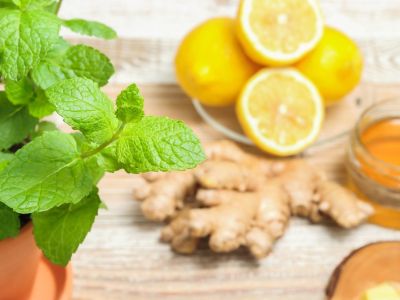Plants such as lavender, basil, and chamomile, and spices such as ginger and turmeric, can be grown in an indoor medicinal herb garden.
How To Grow Medicinal Plants Indoors
Growing a medicinal garden indoors is a bit more challenging than it is outdoors, but it can be done. The trick is to mimic outdoor conditions as much as possible. Site the medicinal herb garden near a sunny window, such as south or west facing, away from heater vents and temperature extremes. Five hours of sun a day is ideal. However, during the winter, provide the plants 14 to 16 hours a day of supplemental light from a fluorescent or LED light. For the soil, use two parts of a commercial soilless mix with one part perlite in a container with plenty of drainage holes. Leaner is better for most herbs, but they should benefit from a light fertilizer every few months. Water regularly but allow the soil to dry out between waterings. To raise the humidity around the plants, mist them daily, or place the containers on a pebble tray. When summer arrives, move the perennial herbs outdoors and bring them back in before a frost. Annual herbs can grow inside year-round but should be replaced yearly. Here are tips for growing a medicinal garden:
German chamomile (Matricaria chamomilla) is an annual that needs 5 to 6 hours of sun a day or 12 to 16 hours of artificial light. Its dried flowers are used in soothing teas to relieve tension and anxiety. Basil (Ocimum basilicum) is also grown as an annual and will do well indoors. Provide six hours of sun, preferably from a south-facing window. It needs a nutrient-rich soil so fertilize regularly with an organic fertilizer. Its leaves are used as a tea to relieve stomach problems, indigestion, and constipation. Lavender (Lavandula) is grown for its calming scent and is used medicinally to cure headaches and insomnia, and to relieve tension. Give it as much sun as possible from a south-facing window. Though it is drought tolerant, it performs best when watered regularly, Harvest flowers in the morning when the oil is at its highest. Its leaves and flowers are used in teas, potpourri, and sachets. Spices such as ginger (Zingiber officinale) and turmeric (Curcuma longa) can be grown indoors by planting the rhizomes in soil 2 inches deep. Purchase rhizomes at the grocery store or from an online nursery and cut into pieces with two or three buds. When foliage appears, move them to a sunny window. Keep the soil moist but not wet. Move them outside when weather warms but be sure to bring them back in when temperatures drop to 50 degrees F (10 C). After 8 or 10 months, the foliage will die back, and you are ready to harvest. Ginger is an anti-inflammatory and an immune booster. Turmeric, a relative of ginger, is an anti-inflammatory and antioxidant with many other touted medicinal benefits.
Medicinal plants and herbs will make a fragrant as well as beneficial addition to an indoor garden. Disclaimer: The contents of this article are for educational and gardening purposes only. Before using ANY herb or plant for medicinal purposes, please consult a physician or a medical herbalist for advice.
